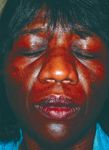
- General Dermatology
- Eczema
- Chronic Hand Eczema
- Alopecia
- Aesthetics
- Vitiligo
- COVID-19
- Actinic Keratosis
- Precision Medicine and Biologics
- Rare Disease
- Wound Care
- Rosacea
- Psoriasis
- Psoriatic Arthritis
- Atopic Dermatitis
- Melasma
- NP and PA
- Skin Cancer
- Hidradenitis Suppurativa
- Drug Watch
- Pigmentary Disorders
- Acne
- Pediatric Dermatology
- Practice Management
- Prurigo Nodularis
Article
Women of color pose distinctive set of age-related cosmetic concerns
New York - The increased pigment in darker skin types helps protect women of color against photodamage, but poses other important cosmetic issues for this patient population, says Valerie D. Callender, M.D.
New York - The increased pigment in darker skin types helps protect women of color against photodamage, but poses other important cosmetic issues for this patient population, says Valerie D. Callender, M.D.
"Having more pigment is a two-edged sword with both good and bad consequences. Darker-skinned persons develop UV-induced wrinkles and textural changes later in life and of lesser severity than their lighter-skinned counterparts. However, they are at greater risk for dyschromias, particularly mottled hyperpigmentation, that can also be cosmetically disfiguring," says Dr. Callender, who is clinical assistant professor of dermatology, Howard University College of Medicine, Washington, D.C., and director of the Callender Skin & Laser Center in Mitchellville, Md.

Two relatively new combination products include a fixed triple-combination cream containing hydroquinone 4 percent, tretinoin 0.05 percent and fluocinolone acetonide 0.01 percent (Tri-Luma Cream, Galderma) and a dual agent combining hydroquinone 4 percent plus retinol encapsulated in a patented, porous microsphere delivery system (EpiQuin Micro, SkinMedica). The tretinoin-containing agent may be a particularly rational choice for treating hyperpigmentation in aging ethnic skin, Dr. Callender observes.
"Treatment of UV-induced dyschromia and other causes of hyperpigmentation is off-label. However, this modality has been shown to be highly effective for clearing hyperpigmentation in melasma trials, and its tretinoin content is an added benefit when treating aging skin because of its effects on photodamage," she says.
Chemical peels can be a safe and useful choice for treating hyperpigmentation, and when indicated, a superficial or medium-depth peel usually suffices, because the excess pigment resides in the epidermis and upper dermis.
Microdermabrasion, which causes only very superficial exfoliation, tends to provide only transient improvement and so is generally reserved for individuals who cannot tolerate a chemical peel, such as those with a history of past sensitivity, atopy or rosacea.
Midfacial changes In addition to dyschromias, important cosmetic concerns for persons with skin of color include traumatic and inflammatory alopecias, acne scarring, dermatitis papulosa nigra, pseudofolliculitis barbae, hirsutism, idiopathic guttate hypomelanosis and keloids/hypertrophic scars. Manifestations of aging in women of color also include prominent midfacial changes characterized by infraorbital hollowing, malar fat ptosis and deepening of the nasolabial fold, Dr. Callender says.
"Since upper and lower face wrinkles occur later in life in darker-skin patients, they are not often considered as candidates for botulinum toxin injections and facial skin rejuvenation. However, they are prime targets for soft tissue augmentation," she observes.
The new hyaluronic acid products have been a significant advance in filling materials for treating skin of color. Due to its white viscous nature, injectable collagen would sometimes result in the appearance of hypopigmentation if placed too superficially.
"That is not a concern with the hyaluronic acid products because they are composed of a clear gel," Dr. Callender explains.
Published data on racial or ethnic differences in botulinum toxin injection and soft tissue augmentation are lacking.
Disclosure: Dr. Callender is a consultant and/or investigator for a number of companies that market products for treatment of cosmetic skin problems, including Galderma, Medicis, Allergan and SkinMedica.
For more information:
Callender VD. Cosmetic surgery in skin of color. Cosmetic Dermatology 2003; 16:S3:S53-56.
2 Commerce Drive
Cranbury, NJ 08512
All rights reserved.





